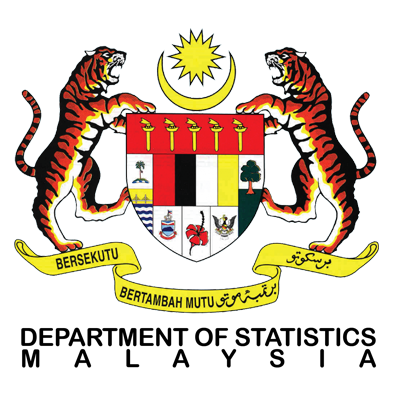Selected Agricultural Indicators
- Home
- Statistics
- Economy
- Agriculture
- Selected Agricultural Indicators
Selected Agricultural Indicators, Malaysia, 2020
Selected Agricultural Indicators, Malaysia, 2019 29 November 2019
Selected Agricultural Indicators, Malaysia, 2018 31 December 2018
Selected Agricultural Indicators, Malaysia, 2017 22 December 2017
Selected Agricultural Indicators, Malaysia, 2016 30 December 2016
Selected Agricultural Indicators, Malaysia, 2015 30 November 2015
Selected Agricultural Indicators, Malaysia 2014 Show all release archives
Overview
Selected agricultural indicators significantly narrowing down in 2020
The publication of Selected Agricultural Indicators, Malaysia, 2021 consists of statistics on economic performance, employment, domestic production and external trade in the agriculture sector. These statistics detail the findings from a sectoral perspective for the three main agriculture sub-sectors, namely crops, livestock and fisheries, as well as the social perspective that contribute to Malaysia's economic position in 2020.
Malaysia's Gross Domestic Product (GDP) performance in 2020 declined 5.6 per cent influenced by the decline in all sectors of the economy as compared to a positive growth of 4.4 per cent in 2019. The contribution of the agriculture sector to Malaysia's GDP in 2020 is 7.4 per cent. The percentage growth of this sector declined 2.2 per cent from 2.0 per cent in the previous year. The decline was due to the commodity sub-sector, especially oil palm, which recorded a negative growth of 3.6 per cent (2019: 1.5%). Although the growth rate of oil palm showed a decline, it was the main contributor to the value added of the agriculture sector with RM36.9 billion or 37.1 per cent.
At the ASEAN level, the contribution of the agriculture sector to GDP was between 0.03 to 22.8 per cent. Myanmar and Cambodia recorded the highest contribution of GDP with 22.8 per cent. This was followed by Lao PDR (16.2%) and Viet Nam (14.9%). On the other hand, Singapore recorded the lowest GDP contribution of 0.03 per cent. Malaysia is ranked eighth out of 10 ASEAN countries. Meanwhile, all ASEAN countries except Singapore recorded an increase in a contribution of agriculture sector to GDP as compared to 2019.
Overall, the production of major commodity crops in 2020 has decreased as compared to 2019. The production of fresh fruit bunches (oil palm) decreased by 2,096.1 thousand tonnes or 2.1 per cent but it was the highest production in agricultural commodities. This was followed by natural rubber and pepper which recorded a decrease of 125.1 thousand tonnes and 3.1 thousand tonnes respectively.
The production of vegetables in Malaysia showed an increase of 0.9 per cent in 2020 with Pahang remained the highest producer with a contribution of 35.1 per cent, followed by Johor (20.2%) and Kelantan (12.5%). Meanwhile, fruit production decreased by 0.7 per cent during the same period. Johor was the highest producer state of fruit in Malaysia with a contribution of 36.0 per cent, followed by Pahang (13.0%) and Sarawak (11.2%).
Looking at the livestock sub-sector, the number of livestock has been increasing except for buffaloes, sheep and swine. Although the livestock population showed an increase, the production has decreased except for poultry meat, chicken/ duck egg as well as fresh milk. The decline in some commodities was also attributed to the lack of demand by restaurants, eateries and hotels that were not operating or having restriction in operations as a result of the COVID-19 pandemic.
Landings of marine fish in 2020 were 1,383.3 thousand tonnes, declined 5.0 per cent from 1,455.4 thousand tonnes in 2019. The declined was due to lack of the number of vessel operations in deep sea, resulted from the restrictions on the re-entry of foreign labour. At the same time, brackishwater and freshwater aquaculture production also decreased by 1.4 and 7.1 per cent respectively from the previous year.
The Labour Force Participation Rate (LFPR) in 2020 decreased by 0.3 percentage points. The number of employed person in 2020 is 14,956.7 thousand (2019: 15,073.4 thousand persons). Of the total, 1,566.0 thousand persons (10.5%) were involved in the agricultural sector. The employed person of the agricultural sector is still dominated by the citizen population with 67.9 per cent while the rest are non-citizens.
Total agricultural exports increased from RM115.5 billion in 2019 to RM118.6 billion in 2020. Meanwhile, total imports of the agriculture sector also showed an increase to RM98.0 billion in 2020 as compared to RM93.5 billion in 2019.
In cognisance of the significance of the pandemic impact on agriculture production and prices, food security has become more important. This indicates that there is a need to revisit the agriculture sector as a potential source of employment opportunities and increased capital investment in modernising this sector. Emphasis on ensuring the stability of food supply is necessary especially for agricultural items that have inadequate self-sufficiency ratio and high import dependency. In addition, emphasis should also take into account accessibility to food especially to the low-income group due to volatility of price factor.


Released By:
DATO' SRI DR. MOHD UZIR MAHIDIN
CHIEF STATISTICIAN MALAYSIA
DEPARTMENT OF STATISTICS, MALAYSIA
![]() DrUzir_Mahidin
DrUzir_Mahidin ![]()
![]() Dr_Uzir
Dr_Uzir
29 November 2021
Contact person:
Mohd Yusrizal bin Ab. Razak
Public Relation Officer
Strategic Communication and International Division
Department of Statistics, Malaysia
Tel : +603-8885 7942
Fax : +603-8888 9248
Email : yusrizal.razak[at]dosm.gov.my
Subscribe
Newsletter
Subscribe to our newsletter and stay updated
For interviews, press statement and clarification to the media, contact:
Baharudin Mohamad
Public Relation Officer
Email: baharudin[at]dosm.gov.my
Phone: 03 8885 7942
Not found what you looking for? Request data from us, through
Go to eStatistik
email to data[at]dosm.gov.my
call 03 8885 7128 (data request)










